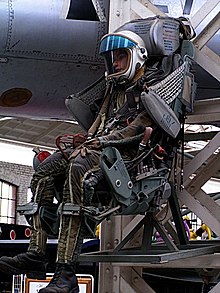Pressure suit
A pressure suit is worn in ambient pressure conditions which, without appropriate protective measures, pose a risk to human health or are even life-threatening.
Pilot height protection suit
Basics
When ascending by plane (or in high mountains) the earth's atmosphere becomes more and more hostile to humans with increasing altitude due to the decreasing air pressure and the resulting reduced amount of inhaled oxygen and the falling temperatures without appropriate protection. The gases inside the body expand due to the lower external pressure. This is expressed through physical reactions, such as the perception of ear pressure or pain in the area of the paranasal , maxillary and frontal sinuses . From 10,000 feet(approx. 3,000 m) symptoms such as shortness of breath, increasing tiredness and / or drowsiness occur. Over 20,000 feet (approx. 6,100 m) the oxygen pressure decreases so much that additional oxygen has to be supplied , for example through breathing masks . From 34,000 feet (approx. 10 km) 100% oxygen is necessary to achieve the partial pressure that acts at sea level. Above 40,000 feet (approx. 12 km), 100% oxygen must be breathed at a metered pressure higher than that of the ambient air in order to maintain the oxygen partial pressure level of air (with 21% oxygen content) of 10,000 feet. When staying at altitudes above 50,000 feet (approx. 15 km) a pressure suit must be worn, which relieves the lungs (the respiratory tract and communicating body cavities) from the pressure difference inside versus outside, from 65,000 feet (approx. 20 km) protective suits are required allow survival in a vacuum . If a person stays unprotected in these pressure conditions for a long time or if there is a rapid pressure drop in the cabin , there is a risk that nitrogen dissolved in the blood will become gaseous. The result would be decompression sickness with neurological disorders (failure of the brain and nerve areas), paresthesias (sensory disorders such as itching), numb feeling and pain in the joints (so-called bends) and / or breathing disorders (so-called chokes).
Technical measures
Pressurized cabins are used to create an “artificial climate” for the crews and passengers of aircraft . In combat aircraft, the cabin pressure behaves differently than in passenger aircraft below 10,000 feet, analogous to the ambient pressure. Above this height, an internal pressure is generated in the cabin, which decreases more slowly than the external pressure. This procedure is maintained up to a maximum cabin pressure altitude of 18,000 feet and then the pressure is held. Oxygen masks must therefore be put on to protect against a lack of oxygen . In order to additionally protect the crew from the consequences of decompression sickness during rapid decompression (e.g. loss of the cabin roof or damage after being shot at), height protection suits are worn.
Pressure suits
Pressure suits are completely closed systems that surround the body. A pressure level is generated in them that enables the wearer to stay at great heights for a longer period of time. They consist of the suit, connectable boots, gloves and a hermetically sealed helmet. A significant disadvantage of these suits is the limited mobility.
Pressure suits are used in aircraft that operate at very high altitudes over long periods of time, such as the David Clark S1030 Suit in the Lockheed SR-71 altitude reconnaissance aircraft . In the Warsaw Pact air force , special height protection suits were worn during an appropriately planned flight profile.
In 1931 the Soviet inventor Yevgeny Tschertowski developed the first pressure suit in Leningrad, but it was impractical.
1934 developed Wiley Post of the Goodrich Corporation with Russell S. Colley common to the first practical pressure suit. On September 5, 1934, he reached an altitude of 40,000 feet over Chicago . This enabled him to fly in the jet stream.
Partial pressure suits
Since combat aircraft often only have short missions at high altitudes, a compromise solution using partial pressure suits is used. In order to prevent oxygen deficiency symptoms and decompression sickness in the pilot in the event of rapid decompression until he can reach a safe altitude (the so-called get-me-down functionality), he is ventilated under pressure with 100% oxygen at high altitudes. In order to compensate for the restrictions that this ventilation technology has on the respiratory and circulatory system, he is protected by a tight-fitting suit. In modern systems, the rubber bladders incorporated for the anti-g suit are also put under pressure, whereby a further narrowing is achieved by one to four times the counter pressure.
Partial pressure suits include the British Aircrew Equipment Assembly (AEA) for the Eurofighter or the NPP Zvezda VKK-6M for various Russian-made aircraft.
Astronaut spacesuit
The space suit is a multi-purpose pressure suit for space travelers, which secures the vital functions of its wearer in the vacuum of space, among other things by putting it under overpressure.
Diver pressure suit
Divers use pressure suits, such as armored suits , to perform particularly deep or long dives. The pressure prevailing in the suit - lower than the high external pressure - enables, among other things, an ascent without decompression .
Web links
- Space Suits in the Encyclopedia Astronautica (English)
Individual evidence
- ^ A Brief History of the Pressure Suit ( Memento March 4, 2010 in the Internet Archive ), NASA
- ↑ Lecture by the head of the Aviation Physiology Department of the Air Force Institute of Aviation Medicine on aspects of flight physiology in the Eurofighter ( Memento from December 24, 2013 in the Internet Archive ) (PDF, 4 MB)
- ↑ Description of the David Clark S1030 Suit by an R + S soldier on wvi.com
- ↑ Description of an interception hunt at peak height on MiG-21.de
-
^ The Effect of Increased Full Coverage Anti-G Trouser Inflation Pressure on the Cardiovascular Responses to Positive Pressure Breathing, Byrne, Lewis and Brown, Center for Human Sciences, Farnborough, 2000

